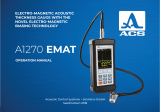
Ultrasonic velocity tester A1410 Pulsar
Operation Manual
5
ACOUSTIC
CONTROL
SYSTEMS
2.3 Intended use of the ultrasonic pulse velocity tester ........................................................................................................15
2.3.1 Setup mode ............................................................................................................................................................................................. 15
2.3.2 Digital mode ..........................................................................................................................................................................................25
2.3.3 Waveform mode ................................................................................................................................................................................. 30
2.4 Transfer data to a PC .................................................................................................................................................................................33
3 MAINTENANCE ..............................................................................................................................................................34
3.1 Battery ....................................................................................................................................................................................................................34
3.2 Charging the battery .................................................................................................................................................................................34
3.3 Possible malfunctions ..............................................................................................................................................................................34
4 STORAGE .........................................................................................................................................................................35
5 TRANSPORTATION ......................................................................................................................................................36
The present operation manual (hereinafter referred to as “Manual”) contains technical speci-
fications, description of the instrument and its operating principle as well as information neces-
sary for correct operation of the ultrasonic pulse velocity tester A1410 (hereinafter referred to as
instrument).
Before starting to work with the instrument, please carefully read the manual.
The manufacturer continuously improves the functionality of the instrument, its reliability
and operational comfort. This may result in some minor changes, not given in the current version
of the manual. These changes do not affect the technical specifications of the instrument.
The instrument is manufactured by:
ACS-Solutions GmbH
Science Park 2
66123 Saarbrucken, Germany
Phone: +49 (0) 681-96592270
Fax: +49 (0) 681-96592280
Website: www.acs-international.com































